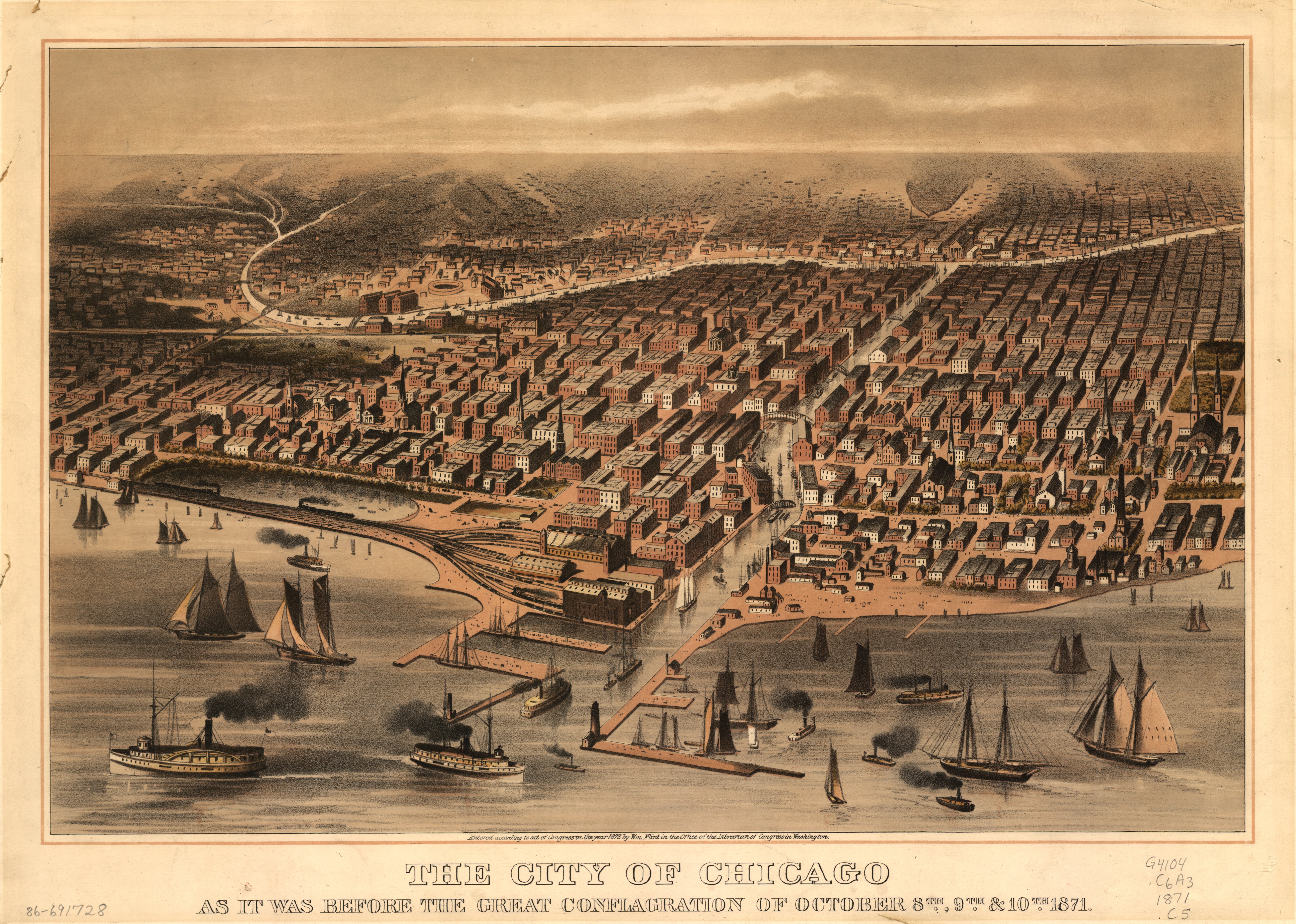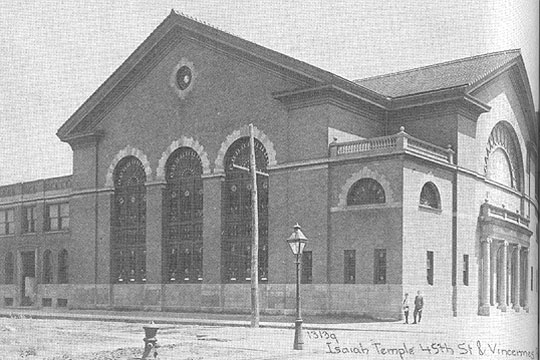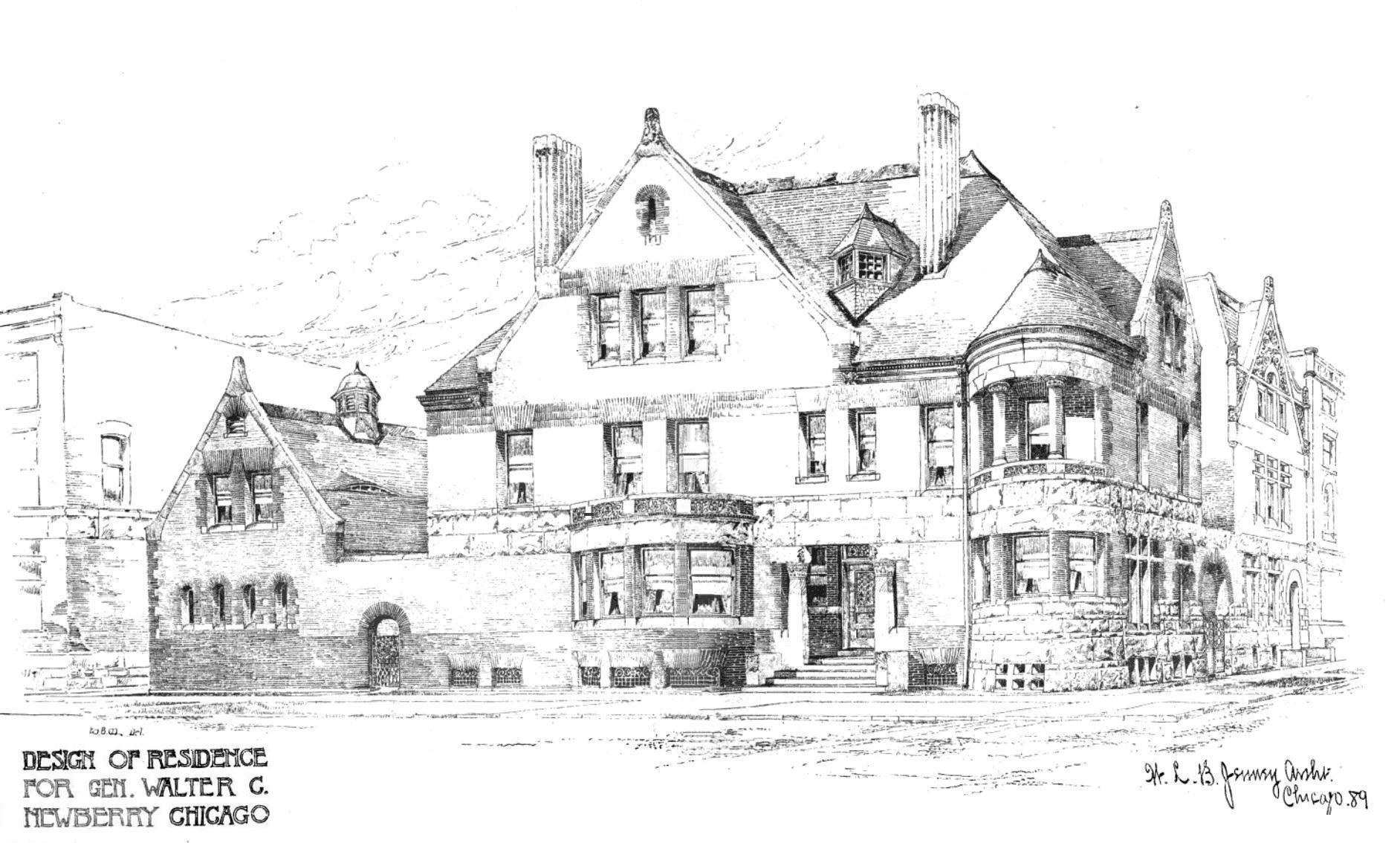|
John M. Van Osdel
John Mills Van Osdel (July 31, 1811 – December 21, 1891) was an American architect who is considered the first Chicago architect. He is considered a peer of the most prominent architects in the history of Chicago. He has also done significant work throughout Illinois and the Midwest, although much of it no longer exists. Biography John M. Van Osdel was born in Baltimore, Maryland on July 31, 1811, the eldest son of carpenter James H. Van Osdel. During John's teenage years, James was temporarily paralyzed in an accident and the family thereafter struggled through poverty. To help the family, John began to work as a carpenter himself. He moved to New York, New York to work with his father once recovery was complete. In the city, Van Osdel found the Apprentice's Library, a catalogue of books related to carpentry and architecture. He returned to Baltimore in 1829 to work. The next year, Van Osdel began a profitable school for prospective draftsmen. In 1836, after another relocation ... [...More Info...] [...Related Items...] OR: [Wikipedia] [Google] [Baidu] |
History Of Chicago
Chicago has played a central role in American economic, cultural and political history. Since the 1850s Chicago has been one of the dominant metropolises in the Midwestern United States, and has been the largest city in the Midwest since the 1880 census. The area's recorded history begins with the arrival of French explorers, missionaries and fur traders in the late 17th century and their interaction with the local Pottawatomie Native Americans. Jean Baptiste Point du Sable was the first permanent non-indigenous settler in the area, having a house at the mouth of the Chicago River in the late 18th century. There were small settlements and a U.S. Army fort, but the soldiers and settlers were all driven off in 1812. The modern city was incorporated in 1837 by Northern businessmen and grew rapidly from real estate speculation and the realization that it had a commanding position in the emerging inland transportation network, based on lake traffic and railroads, controlling acces ... [...More Info...] [...Related Items...] OR: [Wikipedia] [Google] [Baidu] |
University Of Illinois At Chicago
The University of Illinois Chicago (UIC) is a Public university, public research university in Chicago, Illinois. Its campus is in the Near West Side, Chicago, Near West Side community area, adjacent to the Chicago Loop. The second campus established under the University of Illinois system, UIC is also the largest university in the Chicago metropolitan area, having more than 33,000 students enrolled in 16 colleges. It is Carnegie Classification of Institutions of Higher Education, classified among "R1: Doctoral Universities – Very high research activity." The roots of UIC can be traced to the establishment of the Chicago College of Pharmacy in 1859, which was joined in the 1800s by additional medical related schools. It began an undergraduate program toward the end of World War II, and developed its West side campus in the 1960s. In 1982, it consolidated the University of Illinois at Chicago Circle and the University of Illinois at the Medical Center into the present universi ... [...More Info...] [...Related Items...] OR: [Wikipedia] [Google] [Baidu] |
La Porte County's Second Court House, C 1848
LA most frequently refers to Los Angeles, the second largest city in the United States. La, LA, or L.A. may also refer to: Arts and entertainment Music * La (musical note), or A, the sixth note * "L.A.", a song by Elliott Smith on ''Figure 8'' (album) * ''L.A.'' (EP), by Teddy Thompson * ''L.A. (Light Album)'', a Beach Boys album * "L.A." (Neil Young song), 1973 * The La's, an English rock band * L.A. Reid, a prominent music producer * Yung L.A., a rapper * Lady A, an American country music trio * "L.A." (Amy Macdonald song), 2007 * "La", a song by Australian-Israeli singer-songwriter Old Man River Other media * l(a, a poem by E. E. Cummings * La (Tarzan), fictional queen of the lost city of Opar (Tarzan) * ''Lá'', later known as Lá Nua, an Irish language newspaper * La7, an Italian television channel * LucasArts, an American video game developer and publisher * Liber Annuus, academic journal Business, organizations, and government agencies * L.A. Screenings, a te ... [...More Info...] [...Related Items...] OR: [Wikipedia] [Google] [Baidu] |
Great Chicago Fire
The Great Chicago Fire was a conflagration that burned in the American city of Chicago during October 8–10, 1871. The fire killed approximately 300 people, destroyed roughly of the city including over 17,000 structures, and left more than 100,000 residents homeless. The fire began in a neighborhood southwest of the city center. A long period of hot, dry, windy conditions, and the wooden construction prevalent in the city, led to the conflagration. The fire leapt the south branch of the Chicago River and destroyed much of central Chicago and then leapt the main branch of the river, consuming the Near North Side. Help flowed to the city from near and far after the fire. The city government improved building codes to stop the rapid spread of future fires and rebuilt rapidly to those higher standards. A donation from the United Kingdom spurred the establishment of the Chicago Public Library. Origin The fire is claimed to have started at about 8:30 p.m. on October ... [...More Info...] [...Related Items...] OR: [Wikipedia] [Google] [Baidu] |
William W
William is a male given name of Germanic origin.Hanks, Hardcastle and Hodges, ''Oxford Dictionary of First Names'', Oxford University Press, 2nd edition, , p. 276. It became very popular in the English language after the Norman conquest of England in 1066,All Things William"Meaning & Origin of the Name"/ref> and remained so throughout the Middle Ages and into the modern era. It is sometimes abbreviated "Wm." Shortened familiar versions in English include Will, Wills, Willy, Willie, Bill, and Billy. A common Irish form is Liam. Scottish diminutives include Wull, Willie or Wullie (as in Oor Wullie or the play ''Douglas''). Female forms are Willa, Willemina, Wilma and Wilhelmina. Etymology William is related to the given name ''Wilhelm'' (cf. Proto-Germanic ᚹᛁᛚᛃᚨᚺᛖᛚᛗᚨᛉ, ''*Wiljahelmaz'' > German ''Wilhelm'' and Old Norse ᚢᛁᛚᛋᛅᚼᛅᛚᛘᛅᛋ, ''Vilhjálmr''). By regular sound changes, the native, inherited English form of the name should b ... [...More Info...] [...Related Items...] OR: [Wikipedia] [Google] [Baidu] |
Frank Lloyd Wright
Frank Lloyd Wright (June 8, 1867 – April 9, 1959) was an American architect, designer, writer, and educator. He designed more than 1,000 structures over a creative period of 70 years. Wright played a key role in the architectural movements of the twentieth century, influencing architects worldwide through his works and hundreds of apprentices in his Taliesin Fellowship. Wright believed in designing in harmony with humanity and the environment, a philosophy he called organic architecture. This philosophy was exemplified in Fallingwater (1935), which has been called "the best all-time work of American architecture". Wright was the pioneer of what came to be called the Prairie School movement of architecture and also developed the concept of the Usonian home in Broadacre City, his vision for urban planning in the United States. He also designed original and innovative offices, churches, schools, skyscrapers, hotels, museums, and other commercial projects. Wright-designed inter ... [...More Info...] [...Related Items...] OR: [Wikipedia] [Google] [Baidu] |
John Wellborn Root
John Wellborn Root (January 10, 1850 – January 15, 1891) was an American architect who was based in Chicago with Daniel Burnham. He was one of the founders of the Chicago School style. Two of his buildings have been designated a National Historic Landmark; others have been designated Chicago landmarks and listed on the National Register of Historic Places. In 1958, he was posthumously awarded the AIA Gold Medal. Early years and education John Wellborn Root was born in 1850 in Lumpkin, Georgia, the son of Sidney Root, a planter, and his wife, Mary Harvey Clark. He was named after a maternal uncle, Marshall Johnson Wellborn. Root was raised in Atlanta, where he was first educated at home. When Atlanta fell to the Union during the American Civil War, Root's father sent young Root and two other boys on a steamer to the United Kingdom, where his father, Sidney, had a shipping business based in Liverpool, England. His mother and sister went to Cuthbert, Georgia. While in ... [...More Info...] [...Related Items...] OR: [Wikipedia] [Google] [Baidu] |
Daniel Burnham
Daniel Hudson Burnham (September 4, 1846 – June 1, 1912) was an American architect and urban designer. A proponent of the '' Beaux-Arts'' movement, he may have been, "the most successful power broker the American architectural profession has ever produced." A successful Chicago architect, he was selected as Director of Works for the 1892–93 World's Columbian Exposition, colloquially referred to as "The White City". He had prominent roles in the creation of master plans for the development of a number of cities, including the Plan of Chicago, and plans for Manila, Baguio and downtown Washington, D.C. He also designed several famous buildings, including a number of notable skyscrapers in Chicago, the Flatiron Building of triangular shape in New York City, Union Station in Washington D.C., London's Selfridges department store, and San Francisco's Merchants Exchange. Although best known for his skyscrapers, city planning, and for the White City, almost one third of Burnham's ... [...More Info...] [...Related Items...] OR: [Wikipedia] [Google] [Baidu] |
Louis Sullivan
Louis Henry Sullivan (September 3, 1856 – April 14, 1924) was an American architect, and has been called a "father of skyscrapers" and "father of modernism". He was an influential architect of the Chicago School, a mentor to Frank Lloyd Wright, and an inspiration to the Chicago group of architects who have come to be known as the Prairie School. Along with Wright and Henry Hobson Richardson, Sullivan is one of "the recognized trinity of American architecture". The phrase "form follows function" is attributed to him, although he credited the concept to ancient Roman architect Vitruvius (as it turns out never said anything of the sort). In 1944, Sullivan was the second architect to posthumously receive the AIA Gold Medal. Early life and career Sullivan was born to a Swiss-born mother, Andrienne List (who had emigrated to Boston from Geneva with her parents and two siblings, Jenny, b. 1836, and Jules, b. 1841) and an Irish-born father, Patrick Sullivan. Both had immigrate ... [...More Info...] [...Related Items...] OR: [Wikipedia] [Google] [Baidu] |
Dankmar Adler
Dankmar Adler (July 3, 1844 – April 16, 1900) was a German-born American architect and civil engineer. He is best known for his fifteen-year partnership with Louis Sullivan, during which they designed influential skyscrapers that boldly addressed their steel skeleton through their exterior design: the Wainwright Building in St. Louis, Missouri (1891), the Chicago Stock Exchange Building (1894), and the Guaranty Building in Buffalo, New York (1896). Early years Adler was born in Stadtlengsfeld, Germany; his mother, Sara Eliel, died when he was born. In 1854, he came to the United States with his father Liebman, a rabbi. They took up residence in Detroit, and Liebman became the rabbi of Congregation Beth-El. Subsequently, they moved to Chicago. Adler had some elementary-level education in the City of Detroit, and Ann Arbor, before leaving school to become a draftsman. Career Adler served in the Union Army during the Civil War with Battery "M", 1st Illinois Light Artillery ... [...More Info...] [...Related Items...] OR: [Wikipedia] [Google] [Baidu] |
William LeBaron Jenney
William Le Baron Jenney (September 25, 1832 – June 14, 1907) was an American architect and engineer who is known for building the first skyscraper in 1884. In 1998, Jenney was ranked number 89 in the book ''1,000 Years, 1,000 People: Ranking the Men and Women Who Shaped the Millennium''. Life and career Jenney was born in Fairhaven, Massachusetts, on September 25, 1832, son of William Proctor Jenney and Eliza LeBaron Gibbs. Jenney began his formal education at Phillips Academy, Andover, in 1846, and at the Lawrence Scientific school at Harvard in 1853, but transferred to École Centrale des Arts et Manufactures (École Centrale Paris) to study engineering and architecture. At École Centrale Paris, he learned the latest iron construction techniques as well as the classical functionalist doctrine of Jean-Nicolas-Louis Durand (1760-1834) - Professor of Architecture at the Ecole Polytechnique. He graduated in 1856, one year after his classmate, Gustave Eiffel, the design ... [...More Info...] [...Related Items...] OR: [Wikipedia] [Google] [Baidu] |
Chicago School (architecture)
Chicago's architecture is famous throughout the world and one style is referred to as the Chicago School. Much of its early work is also known as Commercial Style. In the history of architecture, the first Chicago School was a school of architects active in Chicago in the late 19th, and at the turn of the 20th century. They were among the first to promote the new technologies of steel-frame construction in commercial buildings, and developed a spatial aesthetic which co-evolved with, and then came to influence, parallel developments in European Modernism. A "Second Chicago School" with a modernist aesthetic emerged in the 1940s through 1970s, which pioneered new building technologies and structural systems, such as the tube-frame structure. First Chicago School While the term "Chicago School" is widely used to describe buildings constructed in the city during the 1880s and 1890s, this term has been disputed by scholars, in particular in reaction to Carl Condit's 1952 book ''Th ... [...More Info...] [...Related Items...] OR: [Wikipedia] [Google] [Baidu] |

_(14592057920).jpg)






